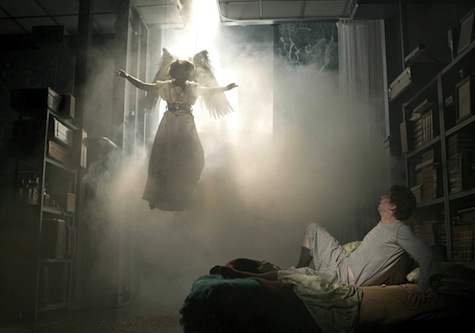Transcendence ain’t all clouds and rainbows.
Plenty of people who have experienced the numinous—that ecstatic feeling that you’re in touch with something greater than yourself—may struggle to understand what has happened and what it means. This may be especially true if they’re rationalists.
Consider Barbara Ehrenreich, the activist and writer who is perhaps most famous for writing Nickel and Dimed: On (Not) Getting By in America, and describes herself as a “hard-core atheist” and rationalist. Her new book, Living with a Wild God, is about several numinous experiences she had as a teenager, but was never able to talk about before now.
In a recent opinion piece for the New York Times Ehrenreich describes one such experience that happened when she was seventeen:
Thanks to a severely underfunded and poorly planned skiing trip, I was sleep-deprived and probably hypoglycemic that morning in 1959 when I stepped out alone, walked into the streets of Lone Pine, Calif., and saw the world—the mountains, the sky, the low scattered buildings—suddenly flame into life. There were no visions, no prophetic voices or visits by totemic animals, just this blazing everywhere. Something poured into me and I poured out into it.
As a non-believer, Ehrenreich had no religious framework for describing what happened to her, and so attributed it to a mental breakdown. For most of her life she was afraid to tell anyone about it.
I had my own encounter with the numinous when I was a teenager—though it happened in a church and not in the desert. And because I was being raised as a Baptist and not an atheist, I had a ready-made interpretation for what had happened. My experience wasn’t uncommon in my congregation; in fact, it was expected.
 But later, I started thinking differently about what had happened to me, and put some of my ideas into my new novel, Afterparty. The main character, Lyda, overdoses on a designer drug that leaves her with a permanent deity only she can see. As a neuroscientist, Lyda knows that the angelic Dr. Gloria is a hallucination. The illusion is so strong, however, that Lyda can’t stop talking to her. The kicker is that Dr. Gloria is a calming, rational presence. Lyda’s a better person with her delusion than without her.
But later, I started thinking differently about what had happened to me, and put some of my ideas into my new novel, Afterparty. The main character, Lyda, overdoses on a designer drug that leaves her with a permanent deity only she can see. As a neuroscientist, Lyda knows that the angelic Dr. Gloria is a hallucination. The illusion is so strong, however, that Lyda can’t stop talking to her. The kicker is that Dr. Gloria is a calming, rational presence. Lyda’s a better person with her delusion than without her.
That’s not an unusual response, according to the published research. We know that the numinous experience can make you (temporarily, at least) more loving and more humble, and make you feel more connected to your fellow humans. It can encourage you to sacrifice your own goals for the good of others.
Ehrenreich says that she eventually learned that mystical experiences are common—she cites surveys that put the number of people reporting such an experience at over 50%. They can strike anyone, in any culture, to believers and non-believers alike. Moreover, they’ve happened throughout history.
She says that her scientific training led her to think that “an alternative to the insanity explanation would be that such experiences do represent some sort of encounter.” She calls on neuroscience to go beyond just asserting that we are “wired for transcendence” and investigate the idea that we truly are in contact with something else:
There is no evidence for a God or gods, least of all caring ones, but our mystical experiences give us tantalizing glimpses of other forms of consciousness, which may be beings of some kind, ordinarily invisible to us and our instruments.
This is where Ehrenreich’s argument takes a hard left turn, especially for a rationalist. She dismisses gods, but is open to other beings contacting us telepathically—for which there is no evidence either. Or if there is, it is exactly the same subjective evidence that convinces many believers that God exists: that feeling that somebody up there is watching.
But that profundity, that quality of realness, is also just a feeling. If one of the symptoms of the numinous was that it felt “fake,” as some visual hallucinations do, neither Ehrenreich nor anyone else would be lobbying for pursuit of external intelligences.
The brain, after all, is lying to us all the time, about things great and small. It edits our sense of time so that neuronal events that reach the brain at separate times seem to occur simultaneously. It makes us see patterns in random noise. And, in its finest deception, it makes us think that there’s a self behind our eyes that’s steering a body around, an illusion so pervasive and natural-feeling that it makes the numinous look like a cheap card trick.
Given the brain’s spotty reputation, we should think twice before we take its word as evidence for invisible beings. The situation might be different if the recipients of the numinous received novel information from these beings—information that they could not have received any other way—but that hasn’t happened.
Yes, there are anecdotal reports of God or alien intelligences imparting information. SF readers have probably heard of Philip K. Dick’s belief that a pink beam of light told him details about his son’s medical condition. But anecdotes aren’t enough. As Carl Sagan once said, Extraordinary claims require extraordinary evidence.
For now, we’re better off trying to understand how and why the brain generates this numinous feeling. Figuring out the how is no easy task. As Ross Douthat explains in a column responding to Ehrenreich, we don’t even understand how “normal” cognition works. Even so, we at least can design some experiments to test and define these mystical states. And if researchers like Michael Persinger are right, we might even be able to induce them.
The why, however, may be just as difficult to figure out. What’s the evolutionary advantage of the numinous? The other illusions (like keeping the world in synch, or recognizing patterns even when they generate false positives) have survival benefit. There’s even a good argument for why a “self” may help us survive: anticipating the intentions of others, and how they will react to a thing called “you,” is a handy skill for predator and prey alike, but is especially useful for a social ape.
It could be that our ability to experience the numinous is a bug in the system—a side effect of having a self, and imagining the selves of others. The processing of the subconscious is always surfacing into the conscious, and in some cases, that information can feel like it’s coming from outside us, from an “other.” We might forgive the brain if, under duress, the message seems to be coming from the world itself.
Or it could be that the numinous is not a bug but a feature. Perhaps we’ve evolved a tendency for transcendence because it’s a survival advantage. The psychologist Jonathan Haidt thinks group selection might explain why that might be the case. Whatever the reason, we know that it wouldn’t help us survive unless it was convincing.
Bug or feature, the answer to the numinous probably lies not in the stars—or wherever these invisible beings come from—but in ourselves.
Daryl Gregory writes genre-mixing novels, short stories, and comics. He is the award-winning author of Pandemonium, The Devil’s Alphabet, Raising Stony Mayhall, and the short story collection Unpossible and Other Stories. His latest novel is Afterparty, a near-future story about consciousness, religion, and cutting-edge drugs, available now from Tor Books. Daryl lives in State College, Pennsylvania, and can be found online at darylgregory.com.










